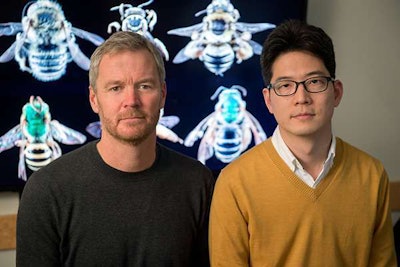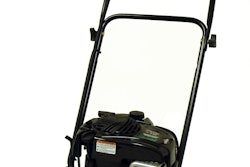 A new University of Vermont study of wild bees identifies 139 counties in key agricultural regions of California, the Pacific Northwest, the Midwest, west Texas and the Mississippi River valley that face a worrisome mismatch between falling wild bee supply and rising crop pollination demand.
A new University of Vermont study of wild bees identifies 139 counties in key agricultural regions of California, the Pacific Northwest, the Midwest, west Texas and the Mississippi River valley that face a worrisome mismatch between falling wild bee supply and rising crop pollination demand.Photo: University of Vermont
Bee populations in areas of the United States that depend most on the pollinators are declining apace, according to new research from the University of Vermont, so much so that the problem may raise farmers’ costs and eventually “destabilize the nation’s crop production.”
For the landscaping industry, the continuing issue of bees’ decline has focused on the insects’ role in horticulture. For the nation as a whole, it’s the potential effect of the decline on crops, not beautiful flowers and shrubbery, that drives efforts such as the National Strategy to Promote the Health of Honey Bees and Other Pollinators.
 A research team led by Insu Koh (right) and Taylor Ricketts, bee experts at the University of Vermont’s Gund Institute for Ecological Economics, estimates that wild bee abundance between 2008 and 2013 declined in 23 percent of the contiguous United States, potentially threatening crop production.
A research team led by Insu Koh (right) and Taylor Ricketts, bee experts at the University of Vermont’s Gund Institute for Ecological Economics, estimates that wild bee abundance between 2008 and 2013 declined in 23 percent of the contiguous United States, potentially threatening crop production.Photo: Sally McCay, University of Vermont
Prepared by a White House task force, the national strategy was released this past May. Now, partly in response to the Obama administration’s call for a comprehensive pollinator assessment, researchers at the University of Vermont’s Gund Institute for Ecological Economics have issued a study mapping wild bees in the United States.
The Gund Institute study, which was published last month in the Proceedings of the National Academy of Sciences, shows that 39 percent of the areas of the continental United States that most depend on pollinators “face a threatening mismatch between rising demand for pollination and a falling supply of wild bees.”
Wild bee populations declined in 23 percent of the continental United States as whole, the researchers found.
Led by Insu Koh at the University of Vermont, the research team noted that more than $3 billion of the annual U.S. agricultural economy depends on pollinators such as wild bees.
The Gund Institute’s director and senior author of the study, Taylor Ricketts, says it has been clear for some time that pollinators are in trouble. (Indeed, the issue of bee colony collapse began to attract worldwide attention late in 2006 and especially in early 2007.) “What has been less clear,” Ricketts says, “is where they are in the most trouble – and where the decline will have the most consequence for farms and food.”
In gathering data on bee ecology as well as land-use patterns for 2008 through 2013, the researchers identified 139 counties across the country where the abundance of wild bees is declining as pollination needs are rising.
 The first national study to map U.S. wild bees suggests they’re disappearing in many of the country’s most important farmlands. Relatively low abundance is shown here in yellow, higher in blue. (Click to enlarge.)
The first national study to map U.S. wild bees suggests they’re disappearing in many of the country’s most important farmlands. Relatively low abundance is shown here in yellow, higher in blue. (Click to enlarge.)Photo: University of Vermont
An issue brief from the Gund Institute for Ecological Economics cites two major policy implications of the study:
- Counties with significant mismatch between crop pollination needs and wild bee abundance should be targeted for private and public habitat programs to support pollinators.
- Investment in monitoring programs is needed to understand future status and trends in wild bee populations and to reduce uncertainty about this in regions with limited information.










